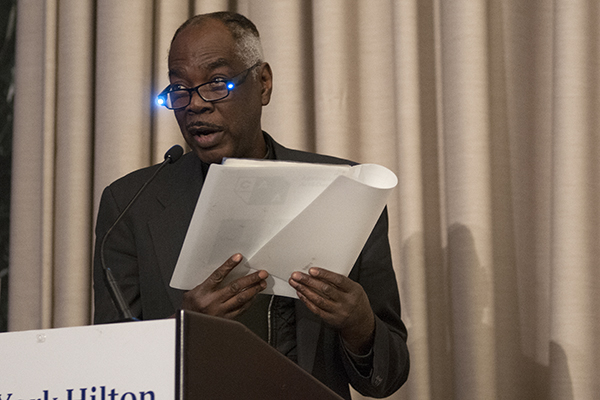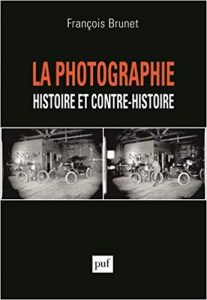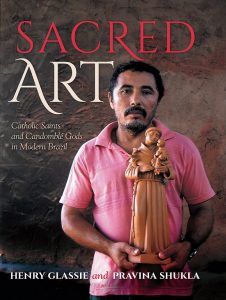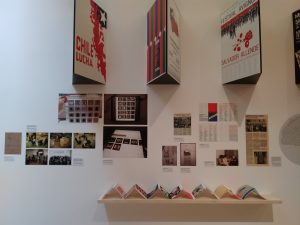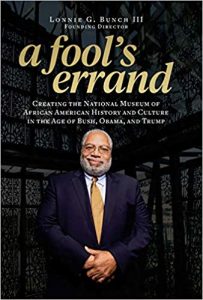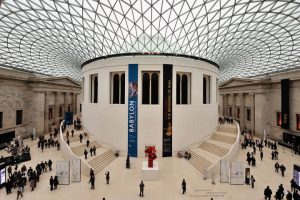CAA News Today
Registration Now Open for the 2020 CAA Annual Conference
posted by CAA — Oct 01, 2019
2020 CAA ANNUAL CONFERENCE
Hilton Chicago
FEBRUARY 12-15, 2020
Four days for everyone in the arts with over 300 sessions and panels, dozens of receptions and parties, professional development workshops, lightning talks, and exhibitors. #CAA2020
For the first time since 2014, the CAA Annual Conference returns to Chicago in February. We welcome all those in the visual arts to attend over 300 sessions and professional development workshops, as well as dozens of receptions, parties, and special tours at local museums and cultural institutions. The Book and Trade Fair, with over one hundred booths showcasing the latest products, programs, and books, will be on the lower level of the Hilton Chicago. Our partners offering free or discounted admission and special tours this year include Art Institute of Chicago, the Field Museum, the Design Museum of Chicago, and many others.
The 108th CAA Annual Conference content will address the full breadth of the field of visual arts and design and will examine a range of cultures, histories, and scholarship. We anticipate more than 5,000 professionals in the arts to attend the conference in Chicago. In collaboration with the Committee on Women in the Arts, we offer 50 percent of the conference’s content in celebration of the Centennial of Women’s Suffrage in the United States, while also acknowledging the discriminatory practices that limited voting rights for Indigenous women and women of color, even after the passage of the 19th amendment in 1920.
We are excited to announce that several renowned artists, designers, and scholars will be speaking at the conference. On Wednesday, February 12, Chicago-based visual artist Amanda Williams will be delivering the keynote address at Convocation. On Friday, February 14, our Artist Interviews will feature Sheila Pepe and Arnold J. Kemp, and this year’s Distinguished Scholar Session, held on February 13, will honor Kellie Jones.
Learn More about our Notable Speakers
Once again, CAA will offer travel grants and scholarships to individuals looking to attend the Annual Conference. With the generous support of Blick Art Materials and Routledge, Taylor & Francis, CAA will provide eight student member registrants with $250 each to attend the conference.
We look forward to seeing you in Chicago!
Please contact Member Services at membership@collegeart.org or at 212-691-1051, ext. 1 with any questions.
News from the Art and Academic Worlds
posted by CAA — Sep 25, 2019

Installation view of Women Take the Floor at the MFA Boston, an effort to dedicate more space to women’s artworks. Only 4 percent of the art acquired by the museum between 2008 to 2018 was by women—3,788 of 90,215 works. Image: Museum of Fine Arts, Boston, via New York Times
Female Artists Made Little Progress in Museums Since 2008, Survey Finds
New data shows that in the last ten years, only 11% of all work acquired by top US museums was by women. (New York Times)
The Getty Trust Will Spend $100 Million to Protect Archaeological Sites Around the World From Climate Change and Sectarian Violence
The organization’s ambitious new initiative includes conservation efforts, scholarship programs, publications, and exhibitions. (artnet News)
‘It’s About Time!’ Betye Saar’s Long Climb to the Summit
The artist’s solo exhibition at MoMA will debut with the reopening of the newly expanded museum on October 21. (New York Times)
How Much Does an Adjunct Actually Make?
“What if everyone just told their students how much they got paid?” According to a 2015 study, one in five part-time faculty members live below the federal poverty line. (Hyperallergic)
Want articles like these in your inbox? Sign up:
News from the Art and Academic Worlds
posted by CAA — Sep 18, 2019
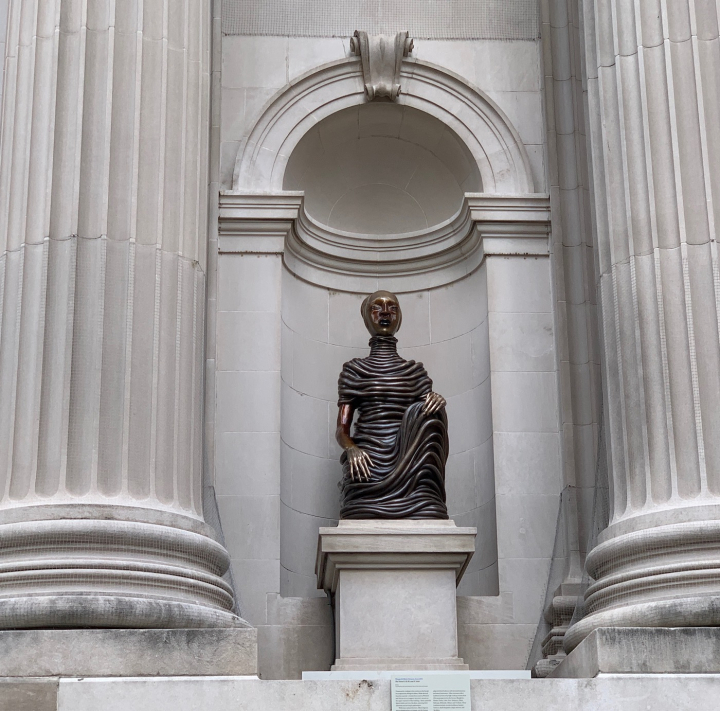
Wangechi Mutu’s The Seated III (2019) in its niche at the Met. Photo: Zachary Small via Hyperallergic
Wangechi Mutu Adorns the Met Museum’s Façade With Images of African Queendom
For the first time in 117 years, the empty niches on the museum’s exterior are occupied. (Hyperallergic)
Minneapolis Team Is Changing Museums from the Inside Out
A project at Minneapolis Institute of Art has spread nationwide—and beyond—as museums confront their colonial past. (Star Tribune)
Congress Promised Student Borrowers A Break. Education Department Rejected 99% Of Them
A new report shows revised efforts to forgive public servants’ student loan debt are still remarkably unforgiving. (NPR)
We’re Getting These Murals All Wrong
Robin D.G. Kelley takes an in-depth look at the Victor Arnautoff mural controversy in San Francisco. Let us know what you think in our online survey. (The Nation)
Want articles like these in your inbox? Sign up:
RAAMP Coffee Gathering: Curatorial Work as Academic Labor
posted by CAA — Sep 17, 2019
RAAMP (Resources for Academic Art Museum Professionals) Coffee Gatherings are monthly virtual chats aimed at giving participants an opportunity to informally discuss a topic that relates to their work as academic art museum professionals.
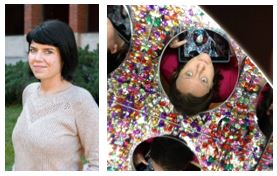
Coffee Gathering: Curatorial Work as Academic Labor
On Tuesday, September 24 at 3:00 PM (EST) RAAMP will be speaking with Meredith Lynn and Claire L. Kovacs.
To RSVP to this coffee gathering, please email Cali Buckley at cbuckley@collegeart.org
Meredith Lynn is an artist, curator, and educator based in Tallahassee, Florida. In her art practice she frequently explores the historical, political, and social issues surrounding land management and ownership. Her curatorial specialty is contemporary art, with a particular focus in interactive and new media art. Her work has been supported by the National Endowment for the Arts, the Indiana Arts Commission, the Minnesota State Arts Board, Northern Lights, and the Florida Department of Cultural Affairs and most recently shown at the Morris Graves Museum of Art in Arcata, California and the Wiregrass Museum in Dothan, Alabama. She is curator of the Museum of Fine Arts at Florida State University where she also teaches in the Department of Art.
Claire L. Kovacs is the Curator of Collections and Exhibitions at Binghamton University. She obtained her PhD from the University of Iowa and her master’s and bachelor’s degrees from Case Western Reserve University – all in art history. She has curated exhibitions at the Figge Art Museum, Coe College, Krasl Art Center, DePaul University, and at Augustana College, where she was (until recently) the Director of the Augustana Teaching Museum of Art. Her strategies for curatorial work and programming emphasize the ways that academic museums explore contemporary issues, foster interdisciplinary inquiry, create space for a multiplicity of voices and perspectives, and function as a site of dynamic community engagement. She underscores intersectional equity, diversity, accessibility and inclusion in her curatorial work. Her research practice grapples with ways that art historical research can support ‘The Common Good’ (to borrow a phrase from the NEH), using curatorial practice and writing as a mechanism by which to amplify under-told stories.
Submit to RAAMP

RAAMP (Resources for Academic Art Museum Professionals) aims to strengthen the educational mission of academic art museums by providing a publicly accessible repository of resources, online forums, and relevant news and information. Visit RAAMP to discover the newest resources and contribute.
RAAMP is a project of CAA with support from The Andrew W. Mellon Foundation.
New in caa.reviews
posted by CAA — Sep 13, 2019
Didier Aubert commemorates the life and work of François Brunet, and reviews Brunet’s book La photographie: Histoire et contre-histoire. Read the full review at caa.reviews.
Matthew Bent discusses the exhibition Past Disquiet: Artists, International Solidarity and Museums in Exile, curated by Kristine Khouri and Rasha Salti. Read the full review at caa.reviews.
Kimberly Cleveland considers Henry Glassie and Pravina Shukla’s Sacred Art: Catholic Saints and Candomblé Gods in Modern Brazil. Read the full review at caa.reviews.
Deborah Ziska writes about Lonnie G. Bunch III’s forthcoming book, A Fool’s Errand: Creating the National Museum of African American History and Culture in the Age of Bush, Obama, and Trump. Read the full review at caa.reviews.
CWA Picks for September 2019
posted by CAA — Sep 12, 2019
CAA’s Committee on Women in the Arts selects the best in feminist art and scholarship to share with CAA members on a monthly basis. See the picks for September below.
FAST FASHION/SLOW ART
Luther W. Brady Art Gallery, The George Washington University, Washington, DC
August 9 – December 15, 2019
Beyond the glitz and glamour of the fashion industry are serious timely questions around waste and consumerism in the garment industry, which is what the contemporary artists and filmmakers explore in Fast Fashion/Slow Art. The diverse group of emerging and established contemporary artists and filmmakers from China, Denmark, Germany, Norway, and the United States includes Julia Brown, Carole Frances Lung (Frau Fiber), Cat Mazza, Senga Nengudi, Martha Rosler, Hito Steyerl, Martin de Thurah, Rosemarie Trockel, and Wang Bing, who collectively encourage scrutiny of today’s garment industry. For example, Bing’s documentary installation, 15 hours, was shot in a factory in China, capturing the labor of some of its 300,000 workers, emitting a meditation on the contemporary meaning of work in present-day China. Also available during the exhibition are two web programs, ”Planet Money Makes a T-Shirt” and “Sweatshop—Deadly Fashion.”
Her Own Way
Female Artists and the Moving Image in Art in Poland: From 1970s to the Present
Tokyo Photographic Art Museum
August 14 – October 14, 2019
The exhibition of artworks by Polish women artists features moving image, which has a rich history in Polish art scene. Women artists have used video and photography even though during the Cold War those working “behind” the Iron Curtain had little access to equipment and training. Despite hardships, women experimented with video expression. Following democratization of the country after the fall of the Berlin Wall and the introduction of the free market economy, Poland welcomed economic growth and material affluence. This contributed to deepening income gaps and rapid changes in value. Polish critical art of the 1990s addressed those contradictions in society. Those who were born under the Communist regime and brought up after democratization started looked back with a critical distance to explore new perspectives and question complex social and political conditions. This has driven a rich and diverse landscape for moving image, including the use of more accessible media. The exhibition features works from 1970s onwards questioning contradictions of the global economic system. It includes some of the key figures in Polish art scene including Bogna Burska, Izabella Gustowska, Zuzanna Janin, Katarzyna Kozyra, Anna Kutera, Natalia LL, Ewa Partum, Agnieszka Polska, Joanna Rajkowska, and Alicja Rogalska, among others.
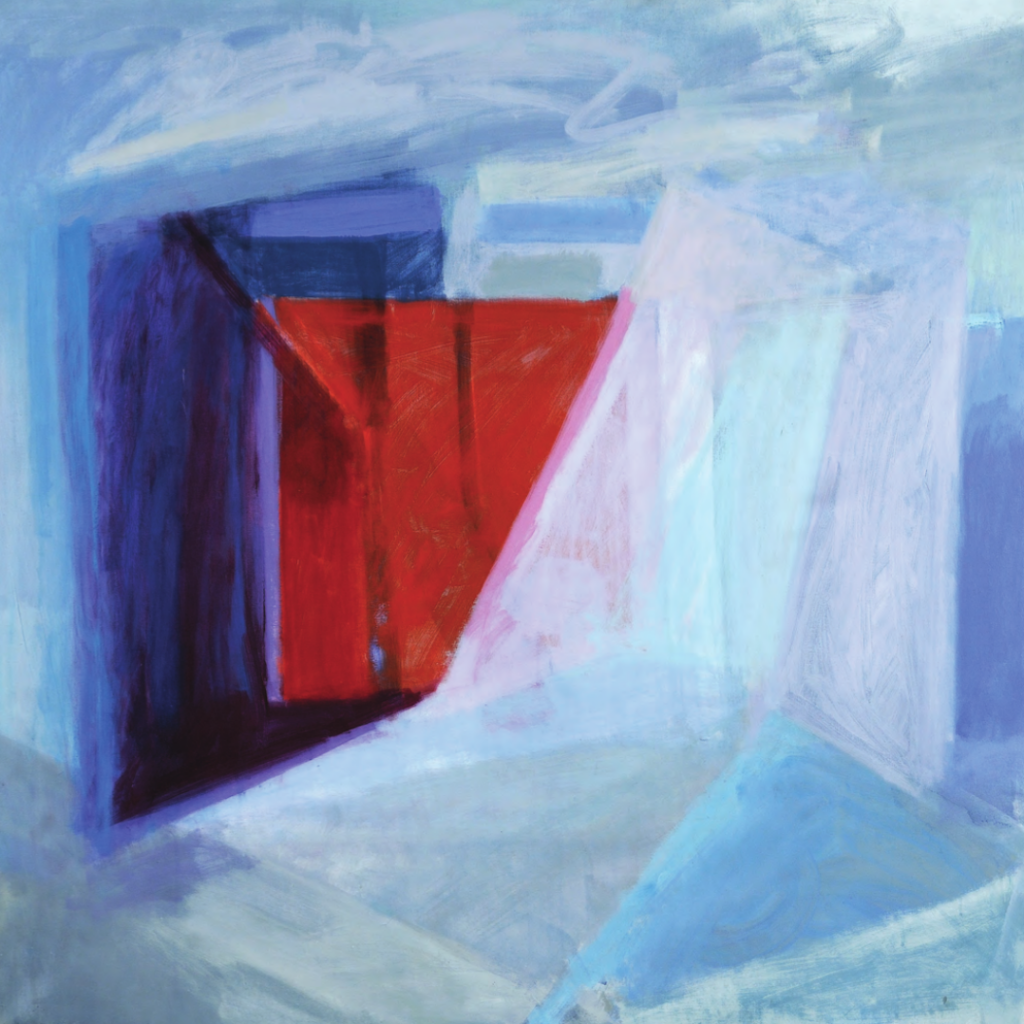
Helene Herzbrun, Entrances (detail), 1977. Acrylic on canvas, framed: 52 5/8 × 52 3/4 × 1 5/8 in., image: 52 × 52 in. American University Museum, X1639.
Grace Hartigan & Helene Herzbrun: Reframing Abstract Expressionism
American University Museum at the Katzen Arts Center, Washington, DC
September 3 – October 20, 2019
The past few years has witnessed an urgent reappraisal of the Abstract Expressionist canon in the United States. Recent game-changers, such as the Women of Abstract Expressionism exhibition and catalogue (2016), and steady growth in the art market, have turned a sharp eye on the women whose careers received little critical and financial support during and after the heyday of heroic gesturalism and figurative abstraction in the 1950s. Norma Broude, the distinguished feminist art historian and professor emerita at The American University, has organized an exhibition that argues for a reframing of the geographic center of New York, and presents a two-person show on Grace Hartigan (1922-2008) and Helene Herzbrun (1922-1984). Both artists, who had a cordial friendship, had lived and exhibited for many decades around the Baltimore and Washington, DC region, and many of the paintings on view are drawn from local private collections and museums. Hartigan, the more celebrated of the two, has received considerable scholarly attention. Her early career in New York was shaped by social relationships with the first generation of Abstract Expressionists, including Jackson Pollock and Willem de Kooning (a seminal influence), and the seductive riffraff of modern life in the fifties around her studio on the Lower East Side. Hartigan often incorporated the popular and material subjects—the “vulgar and vital”—from her surroundings, and Baltimore eventually proved to have much to offer. Her early artistic development was also largely influenced by her own study of paintings at the Metropolitan Museum of Art and transformative friendships with poets Frank O’Hara and Barbara Guest. By 1953, she had the attention of Alfred Barr, Jr. and curator Dorothy C. Miller, who accessioned her Baroque-inspired masterpiece, Persian Jacket (1952), into the permanent collection of the Museum of Modern Art; this was followed by her participation as the only woman artist in MoMA’s groundbreaking exhibitions, 12 Americans (1956) and The New American Painting (1958-1959). Broude’s catalogue essays purposefully consider the negative impact on Hartigan’s career after leaving New York City for Baltimore, and the artist’s serious disappointment in the regional artistic scene. This shifted to some degree when she found support in her new intellectual community as a revered professor and mentor at the Maryland Institute of Art (MICA), Hoffberger School. Comparably, Broude develops a fascinating biographical sketch of Helene Herzbrun, whose archives are held at American University. Herzbrun experienced similar challenges in her desire to establish critical recognition outside the parameters of New York and beyond the stylistic popularity of Color Field painting practiced by her male contemporaries in Washington. Herzbrun maintained an important correspondence with Ab-Ex artist Jack Tworkov, with whom she worked as a MFA student at AU. She was a faculty member in the University’s art department until her death in 1984. Addressing the limited opportunities for artists in the area, Herzbrun co-founded an important cooperative space called Jefferson Place Gallery in DC. Hartigan and Herzbrun make exciting visual partners in Reframing Abstract Expressionism. Their painterly dialogues on nature and the landscape interrogate the creative process and explore the persistent motivations to paint abstractly while negotiating representation, structure, and spontaneity, all essential components of the living language of Abstract Expressionism. This exhibition expands our understanding of the networks of production and distribution of ideas and resources on Abstract Expressionism to the regional centers of the country.
Affiliated Society News for September 2019
posted by CAA — Sep 11, 2019
Affiliated Society News shares the new and exciting things CAA’s affiliated organizations are working on including activities, awards, publications, conferences, and exhibitions.
Interested in becoming an Affiliated Society? Learn more here.
SECAC
The 75th Annual SECAC Conference, hosted by the University of Tennessee at Chattanooga, will be held October 16 through 19, 2019. More than 540 papers—on studio art, art history, art education, and graphic design—will be presented in 142 sessions. All sessions will take place at the Chattanoogan Hotel. Offsite events include the annual SECAC Artist’s Fellowship and Juried Exhibitions and a keynote address by artist, educator, and advocate for artists, Sharon M. Louden, who serves as editor of the Living and Sustaining a Creative Life series of books and Artistic Director of the Visual Arts at Chautauqua Institution. More information and conference registration are available at https://secacart.org/page/Chattanooga.
Society for the Study of Early Modern Women and Gender (SSEMWG)
Foundation for Advancement in Conservation
Material Immaterial: Photographs in the 21st Century Symposium and Seminars
September 23-25, 2019, Yale University, New Haven, CT
Organized by Paul Messier and Monica Bravo
We are witnessing the historic transformation of photography from tangible objects—prints, plates, and negatives—to code: intangible bits, bytes, and pixels. As the tether between visual culture and the material world is recalibrated every day, a new form of literacy is required to draw meaning from physical media and its obsolescence. At the very moment when characterization and interpretation of the printed photograph is rapidly gaining ground, the momentum toward dematerialization raises the issue of the long-term relevance and sustainability of photography as a material fact. Does the physical photograph still matter today—as a source for teaching, learning, and scholarship—and will it matter into the future?
This symposium and elective seminars will provide insight into new tools for researching photographs with an emphasis on both the material and immaterial aspects of the medium. Conservation professionals will gain practical knowledge on new and existing techniques for characterizing prints and collections and how this information can be structured and visualized. Curators and art historians will benefit from exposure to the methods and techniques that underlie the contemporary approaches to material history. Together, the presentations and discussions are meant to demystify techniques adapted from seemingly exotic fields of artificial intelligence and data science and to cover some basic techniques for understanding and interpreting the physical and chemical makeup of a photographic print.
View the program for detailed a schedule and speaker list or visit the event website to register.
Support for this program comes from The Andrew W. Mellon Foundation Fund for Collaborative Workshops in Photograph Conservation, a grant from the National Endowment for the Humanities, and the Foundation for Advancement in Conservation Endowment for Professional Development.
Association for Modern and Contemporary Art of the Arab World, Iran, and Turkey (AMCA)
“AMCA Interview with the Winner of the 2019 Rhonda A. Saad Prize for Best Paper in Modern and Contemporary Arab Art”
The 2019 Rhonda A. Saad Prize for Best Paper in Modern and Contemporary Arab Art was awarded to Lara Ayad for her paper “Homegrown Heroes: Peasant Masculinity and Nation-Building in the Paintings of Aly Kamel al-Deeb.” Dr. Ayad is an Assistant Professor of Art History at Skidmore College. She received her PhD in the History of Art and Architecture at Boston University. An interview with Dr. Ayad about her research may be found on AMCA’s website: http://amcainternational.org/interview-with-lara-ayad/
The Rhonda A. Saad Prize review committee acknowledges that Dr. Ayad’s paper is highly original. The Committee found that her paper was a scrupulously researched examination of the 1930s visual cultural context in which the artist worked in Egypt, when ethnography, social sciences, and fine arts intersected on the body of the muscular, model peasant.
Established in 2010 in honor of our dear and respected colleague and friend, The Rhonda A. Saad Prize aims to recognize and promote excellence in the field of modern and contemporary Arab art. The award is offered to a graduate student or recent post-doctoral scholar working in any discipline whose paper is judged to provide the most significant contribution to the disciplines of Art History and Middle East Studies. For more information and submission guidelines, please visit www.amcainternational.org.
Visual Resources Association
The Visual Resources Association Foundation (VRAF) strives to strengthen the visual resources field by increasing public and professional awareness of visual information management while advocating for the value of images in the teaching and learning environment. The VRAF supports a range of educational activities in multiple formats and venues, for example, instructional tools, regional workshops, online learning, and advocacy materials, to build bridges across the information management and educational communities. The Foundation’s research interests advance scholarship in the field, improve outreach to the larger community on significant issues. These include intellectual property rights, the development of best practices protocols for the dissemination of digital images, and furthering public access to visual resources information. Significant areas of focus include: image collections, technology, metadata, cataloging, visual literacy, and copyright. The VRAF’s educational and research agenda advances scholarship in the field and improves outreach to the larger community.
The VRA Foundation currently offers two types of grant opportunities:
1) Project grants, which provide up to $3,000, awarded to organizations or institutions for programs and projects in the VRAF Grant Areas of Interest. The funds may be used for small, stand-alone projects, pilots or start-up financing for larger projects, or for a component of a larger project. This year’s project grant was awarded to Arden Kirkland, Adjunct Professor at the School of Information Studies at Syracuse University in New York to develop the CostumeCore Toolkit for streamlining the process of developing standards-based, interoperable metadata for collections related to the study of historic clothing.
2) Professional development grants, two awards of a $1,000, are provided to an individual for professional development in the field of visual resources and image management. These grants support attendance at an educational event of the grantee’s choosing (such as, an association conference, symposium or workshop), or enrollment in relevant research activities in the VRAF Grant Areas of Interest.
This Fall, the VRAF is accepting applications for the VRAF Professional Development Grant program (see number 2 above). For consideration, please submit your application by Friday, September 20, 2019, 11:59PM Pacific Time using this online application: https://forms.gle/LHeYeRJFnEniJHJP9. If you have any questions about the VRAF Professional Development Grant or the application process, please contact the VRAF Board of Directors at vrafoundation@gmail.com. The recipient of the Fall 2019 VRAF Professional Development grant will be announced by Friday, October 4, 2019, and must be used before October 4, 2020.
This news is being provided by Maureen Burns, VRA CAA Affiliate Representative, on behalf of the VRAF Board of Directors and Visual Resources Association. For more information, please use the following contacts or social media and view the online links:
maburns@uci.edu
vrafoundation@gmail.com
https://vrafoundation.com
https://twitter.com/vrafoundation
https://www.facebook.com/visrafoundation/
Pacific Arts Association
The annual PAA Europe Conference 2019 entitled “Challenging Times – Provenances in Museums” will take place at the Museum der Kulturen Basel, from 19th to 21st September 2019. The meeting coincides with the exhibition “Thirst for Knowledge meets Collecting Mania.” Papers and reports will respond to the exhibition’s theme, “Museums face challenging times: what seemed a must for an ethnographic museum in the past – such as a collection of skulls – is now a sensitive issue. In collecting, objects were removed from their original contexts, items made of rare and precious materials such as ivory or gold aroused desires, and exotic weapons were acquired by the score. The exhibition explores the motives for this former collecting mania and poses questions as to the appropriate handling of sensitive objects today.” For further information visit https://pacificarts.org
QUEER CAUCUS
National Committee for the History of Art (NCHA)
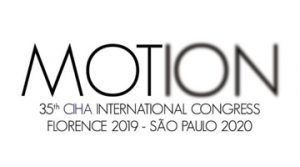
5th CIHA World congress in São Paulo – CALL FOR PAPERS
The CIHA Brazil Committee invites proposals for participation in nine Sessions, six Emerging Scholars Seminars, and a Special Session that will constitute the 35th CIHA World Congress – Motion: Migrations.
The Sessions, Emerging Scholars Seminars, and Special Session are detailed here: https://drive.google.com/file/d/1Qxyun9-gUje83bhCOGtt_d6p8EEMPmFF/view
New Media Caucus (NMC)
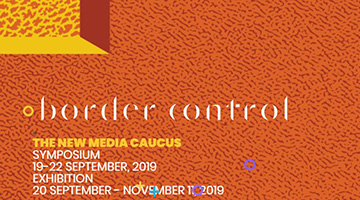 Border Control Symposium and Exhibition
Border Control Symposium and Exhibition
The New Media Caucus (NMC) is proud to present the 2019 Symposium and Exhibition, Border Control at the University of Michigan, Penny W. Stamps School of Art and Design and the Stamps Gallery. The symposium will take place on 19th – 22nd September, 2019, and the exhibition is from 20th September – 11th November, 2019. Keynote Speaker, Vinay Gupta will present a lecture, “Cities that will Walk Away” on 19th September at 5:10pm For more information about the events please visit our website: http://bordercontrol.newmediacaucus.org/
Design Incubation
Colloquium 6.1: Quinnipiac University
Design Incubation Colloquium 6.1 (#DI2019oct) will be held at the School of Communications at Quinnipiac University on Saturday, October 5, 2019.
https://designincubation.com/publications/colloquium/colloquium-6-1-quinnipiac-university/
Practicing Type in the Age of Screens
Saturday, November 9, 2019. 2-5pm. Type Directors Club, NYC
Typeface design and the implementation of typography has never been more exciting. In many cases, type is presented on monitors, tiny and huge electronic visual displays, i.e., screens. In collaboration with the Type Directors Club, Design Incubation will moderate a panel discussion among design innovators about their design and use of type in today’s changing environment. Panelists include Jason Pamental, Javier Mavromantes, Nancy Campbell.
CFP: The Fellowship Program at Design Incubation 2020
Call for Participation: 3-day academic design research and writing workshop in New York City. June 4-6, 2020. Application deadline, October 15, 2019.
Target Audience: Design academics in one or more of the following areas: graphic design, information design, branding, marketing, advertising, typography, web, interaction, film and video, animation, illustration, game design. Full-time tenure track or tenured faculty are given preference but any academic may apply.
https://designincubation.com/call-for-submissions/cfp-the-fellowship-program-at-design-incubation-2020/
CFP: The Design Incubation Residency at Haddon Avenue Writing Institute 2019
Rolling acceptances until Sept 30, 2019. Only 14 seats are available for this event. This 3-day residency allows researchers and scholars time to work on existing writing projects or to start a new writing project. The residency is open to design faculty and to those working in related fields.
https://designincubation.com/design-events/the-design-incubation-residency-at-haddon-avenue-writing-institute-2019/
CFP: A Day of Writing
Come spend an uninterrupted day working on a writing project.
Quinnipiac University School of Communications, October 6th 2019.
https://designincubation.com/design-events/a-day-of-writing/
CFP: Colloquium 6.3: Fordham University
Call for design research abstracts. Deadline: Saturday, December 28, 2019.
https://designincubation.com/call-for-submissions/colloquium-6-3-fordham-university-call-for-submissions/
Association of Art Museum Curators (AAMC)
Apply for AAMC Foundation’s 2020 Engagement Program for International Curators
The AAMC Foundation Engagement Program for International Curators is seeking eligible international and US-based curators interested in pursuing a year-long partnership dedicated to professional development and exchange.
At the core of this Program is a 12-month partnership between a non-US based curator (International Awardee) and a US-based curator (US Liaison) dedicated to reflecting on and developing self-identified areas of advancement with each other. Made possible by major support from the Terra Foundation for American Art, the Program includes travel funding for International Awardees, a participant stipend for US Liaisons, networking, and more, which are outlined in greater detail in the online application, available here: bit.ly/AAMCApply. Two pairings will be awarded.
Eligible applicants must be art curators working on or having worked within exhibitions and projects that explore historical art of the United States (c. 1500-1980), including painting; sculpture; works on paper, such as prints, drawing and photography; decorative arts; performance; and design (except industrial). Architecture and commercial film are excluded. Native American art is eligible for consideration. Additional requirements include a minimum of 50% of the time for/with non-profit organizations will be considered. Please note that curators working in four-wall collecting and non-collecting, community based, and non-four wall organizations, at any location in the globe are eligible.
Through fostering international relationships between curators, AAMC Foundation aims to not only provide opportunities for professional development and exchange, but also strengthen the international curatorial community and increase awareness of the concerns and needs of curators working outside the US. Visit our website to learn more: www.artcurators.org/page/GrantsTerra.
The online application for International Awardees and US Liaisons opens on Wednesday, September 11, 2019, and are due by 12pm ET on Thursday, October 24, 2019.
—
AAMC Foundation Webinar on Utilizing Community Advisory Groups
Join us on Tuesday, September 24, 2019 from 2:00 – 3:15PM ET to learn about the formation, implementation, and utilization of community partners and advisory groups from a dynamic speaker lineup.
From grassroots organizations to large, landmark institutions, museum teams are increasingly engaging with community members to bring history to bear on the narratives told and to bring forward the value of local knowledge. These consultations help develop and shape exhibition themes and checklists, open conversations on collecting practices and directions, and ensure that museum-generated programs accurately and genuinely reflect and engage their communities. From local focus groups to international convenings, the collaborative aspect welcomes perspectives outside the curatorial department.
This webinar explores a diverse range of current approaches, case studies, and lessons learned—from emerging grassroots efforts to established museum outreach. Speakers will address the value in engaging communities, best practices in developing partnerships and advisory groups, and ways to create meaningful and ongoing valued relationships.
Speakers include René Paul Barilleaux, McNay Art Museum; Adrian Locke, Royal Academy of Arts; Regan Pro, Seattle Art Museum; David Serkoak, Key Collaborator with the Canadian Museum for Human Rights; and Ben Tremillo, San Anto Cultural Arts.
There are only a limited amount of spots available. Registration is required: www.artcurators.org/event/communityadvisory
SHERA
The SHERA Board is pleased to announce that the SHERA Graduate Student / Independent Scholar Travel Grant for the 2019 ASEEES meeting has been awarded to Dr. Yulia Karpova (Central European University). Her paper, “Late Soviet studio ceramics as a site of institutional critique” will be presented during the SHERA-sponsored panel “Culture as Matter.”
Anthony Faris and Nick Nelson
posted by CAA — Sep 09, 2019
The weekly CAA Conversations Podcast continues the vibrant discussions initiated at our Annual Conference. Listen in each week as educators explore arts and pedagogy, tackling everything from the day-to-day grind to the big, universal questions of the field.
CAA podcasts are on iTunes. Click here to subscribe.
This week, Anthony Faris and Nick Nelson discuss utilizing technology to connect with audiences in galleries and museums.
Anthony Faris is an artist, curator, and instructor at North Dakota State University in Fargo.
Nick Nelson is the director of the Springfield Art Museum in Springfield, Missouri.
International Review: Vibrancy In Stone: Masterpieces of the Đà Nẵng Museum of Cham Sculpture
posted by CAA — Aug 29, 2019
The following article was written in response to a call for submissions by CAA’s International Committee. It is by Swati Chembakur, an architectural historian at Jnanapravaha, a center for the arts in Mumbai, India. The author is also a 2019 alumna of the CAA-Getty International Program.

Vibrancy in Stone: Masterpieces of the Đà Nẵng Museum of Cham Sculpture, by Trần Kỳ Phương, V. Văn Thắng, and Peter D. Sharrock. Photographs by Paisarn Piemmettawat (Bangkok: River Books, 2018)
In 2018, the University of London’s School of Oriental and African Studies (SOAS) partnered with the Đà Nẵng Museum of Cham Sculpture in central Vietnam to produce a remarkable and visually striking centenary catalogue of its world-renowned collection of the sacred arts of the Cham people of Vietnam. The publication of Vibrancy in Stone: Masterpieces of the Đà Nẵng Museum of Cham Sculpture was timed to coincide with the renovation and expansion of the museum.
Beginning in the second century CE, settlements appeared along the central coast of what became Vietnam. The Chams probably migrated over the ocean from Borneo and were accomplished navigators. Their ports were the first call for any ship heading from China to India and the Arab world. Their role in the medieval maritime trade grew steadily and reached an apogee in the fourteenth and fifteenth centuries, when the great neighboring empire of Cambodia declined. The prosperity won from trade led to large scale temple construction earlier than the Cambodians.

Figure 1. Map of Cham archaeological sites in Vietnam
When tourism resumed in Vietnam after the wars of the twentieth century, the museum quickly became a prime attraction in the port city of Đà Nẵng. It is the world’s only museum devoted exclusively to the art of ancient Champa, the name given to the civilization of the Cham people. With 500 objects on display, its collection far outnumbers those in the Hanoi and Ho chi Minh City History museums, as well as the Musée Guimet in Paris.

Figure 2. Đà Nẵng Museum, Vietnam Photo: Trần Kỳ Phương
In the late nineteenth century, fifty sculptures were gathered by a French colonial administrator and amateur/enthusiastic collector, Charles Lemire, in a public garden at Tourane (Đà Nẵng), forming the embryo of the future museum collection. Some years later, French architect and archaeologist Henri Parmentier took charge of the neglected artworks and proposed a museum for their protection, which opened in 1919 (Fig. 2). He compiled the first comprehensive catalogue.
French colonial research formed the basis of Cham studies. Today a growing number of Vietnamese archaeologists and art historians are taking an active interest in this subject, expanding our understanding of the ancient art. Ethnic Cham scholars still remain few in number. Almost seventy years after Parmentier’s catalogue, a short guidebook to the museum was published about Cham history and art (Trần Kỳ Phương, 1987). It marked the first catalogue of the collection compiled by Vietnamese researchers and highlighted the link between Vietnamese and French research. After the devastating twentieth-century wars in Vietnam, some of the objects in Parmentier’s 1919 catalogue had disappeared, been damaged, or moved to other institutions. At the same time, many recently discovered artifacts have been added to the museum inventory.
Knowledge of Champa’s history, culture, and art, and an appreciation of its richness and uniqueness, has gradually progressed with the accumulation of new data and the engagement of various scholarly disciplines by both national and international scholars. Champa studies no longer appear in only French-language journals, as in the early twentieth century, but now attract a growing number of scholars from Europe, Asia, and North America, who work alongside Vietnamese experts.
Vibrancy in Stone is organized into two parts. Part I includes fourteen essays about the history and culture of Champa by Vietnamese and international scholars. Part II presents a stunningly illustrated chronology of Cham sculpture accompanied by meticulous descriptions and comments by contemporary scholars.
The introductory essay by museum director Vo Văn Thắng discusses the history of the museum, its collection, changing installations over the years, and the current renovation and expansion of the building. Subsequent essays by Kenneth Hall, John Whitmore and Đỗ Trường Giang address the importance of several Champa ports extending along the central Vietnam coast and their active role in the maritime trade network. Champa was probably never a unified state or kingdom but rather a series of loosely linked smaller polities. Its capitals were widely separated settlements on different parts of the coast, which took turns assuming hegemony over others.
Whitmore’s essay delineates fully for the first time the rise of Vijaya (in today’s Bình Đinh province) as the culture’s capital in the ninth century to its sudden demise in the fifteenth century.
Several essays address the Hindu-Buddhist religion, its rituals, archeology, and inscribed objects (by Shivani Kapoor, Ann-Valérie Schweyer, John Guy, Arlo Griffiths, Lâm Thị Mỹ Dung, and—full disclosure—myself) while others (by Trần Kỳ Phương and Parul Pandya Dhar) focus on the architecture, taking the reader through the history of Cham temples and highlighting the evolution of key construction techniques and design features that produced a series of tall, distinctive and elegant brick towers along the coastline (Fig. 3).

Figure 3. Mỹ Sơn valley temple displaying long, elegant brick sanctuaries Photo: Trần Kỳ Phương
The iconography of the beautiful and vibrant Cham sculptures erected in these towers—referenced in the catalogue title—is the subject of chapters by Thierry Zéphir, Grace Chiao-Hui Tu, and Peter D. Sharrock. Cham art has hitherto been almost exclusively studied through an Indic lens but Hui-Tu’s work brings out many new and unseen Sinitic aspects in Cham sacred art. For example, a ninth century monumental sandstone Buddha from Đồng Dương monastery is seated in the “European” position with pendant feet and palms resting on the knees (Fig. 4). While Buddhas seated with pendant legs can be found in Indian, Southeast Asian, and Chinese Buddhist art traditions, this particular hand posture is seen only in China and Đồng Dương.

Figure 4. Đồng Dương pedestal from Đồng Dương, Quảng Nam. 9th century, sandstone, 30 x 177 x 70 in. (76 x 449 x 389 cm); sandstone dais supporting the Buddha, 28 x 87 x 49 in. (70 x 222 x 124 cm). BTC 177-178 Photo: Paisarn Piemmettawat
The question of the relationship between Cham and neighboring Khmers forms the core of the paper by Peter D. Sharrock. Addressing the beautiful Khmer bronze of a naga-enthroned Buddha discovered by the French in the main Cham temple outside Vijaya, he points out that this icon was never part of Cham iconography. He then uses art historical and epigraphic evidence to untie a series of long-distorting knots in the history of the Khmer-Cham relationship.
Part II of Vibrancy in Stone focuses on masterpieces of the museum, one of which is the beautiful bronze illustrated in Figure 5, found in the Đồng Dương monastery in 1978. Earlier labelled as Tārā or Prajñāparāmita, here it has been correctly identified as the female aspect of Avalokitesvara and the main cult image of the monastery.
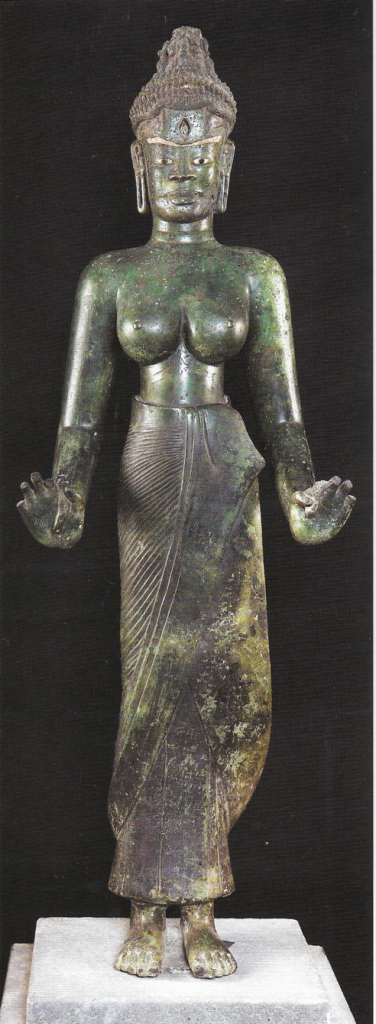
Figure 5. Lakṣmīndra-Avalokiteśvara, 9th century bronze found in the monastery of Đồng Dương. height 6 in. (115 cm). Attributes: lotus (right hand) and conch broken at the time of discovery. BTC 1651-BTĐN 535 Photo: Paisarn Piemmettawat
Other masterpieces include the most famous Mỹ Sơn Śivalinga pedestal (Fig. 6a-b), the only Cham sculpture that records the daily spiritual activities of ascetics performing rituals, practicing meditation, conversing, playing musical instruments, treating diseases, etc., and a widely acknowledge high relief of a Trà Kiệu dancer draped in beads (Fig. 7).

Figure 6a. Mỹ Sơn, 8th century temple pedestal displaying several daily ascetic activities, sandstone, 25 ½ x 107 x 131 in. (65 x 271 x 333 cm). BTC 6-22.4 Photo: Trần Kỳ Phương

Figure 6b. Details of the ascetic activities depicted on the Mỹ Sơn pedestal. Photo: Paisarn Piemmettawat
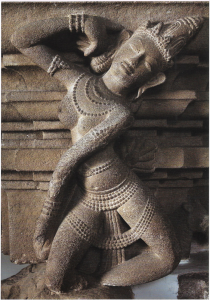
Figure 7. Trà Kiệu dancer/apsaras, Trà Kiệu, Quàng Nam, 11th century, sandstone, 43 x 106 in. (110 x 270 cm). BTC 118/1-22.5
Vibrancy in Stone brings together some of the most priceless and rare works of Cham art. As such, it proclaims the value and artistry of works by the Cham people whose heirs today are an ethnic minority in Vietnam. Equally important, it gathers together these beautiful and rare works of art as a resource for scholars, students, and connoisseurs alike.
News from the Art and Academic Worlds
posted by CAA — Aug 28, 2019
Want articles like these in your inbox? Sign up:
A New Definition of “Museum” Sparks International Debate
The International Council of Museums’s proposed definition—which incorporates mention of “human dignity and social justice”—has stirred debate among the consortium’s 40,000 professionals. (Hyperallergic)
Don’t Stress the New Semester
If you’re scrambling to create a syllabus, find useful readings, and develop effective assignments, remember you don’t have to recreate the wheel. Here’s a great round up of resources from AHTR. (Art History Teaching Resources)
The Met Is Investigating Objects in Its Collection With Ties to Disgraced Dealer Subhash Kapoor. Will Other Museums Follow Suit?
Kapoor was arrested in 2011 for allegedly operating one of the largest antiquities smuggling operations in the world. (artnet News)
Sexism in the Academy
While there were significant gains during much of the 20th century, feminist progress in the academy has slowed—and may have already come to a halt. (n+1)



